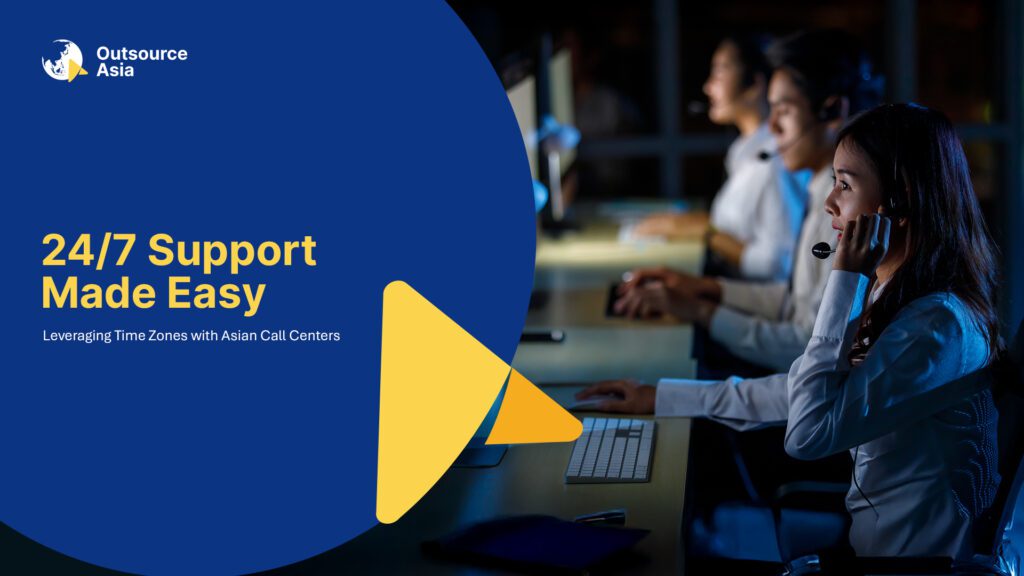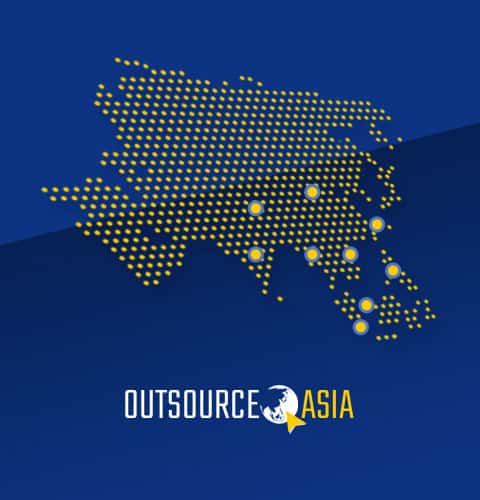The idea of customer service “closing for the night” feels outdated in 2025. The modern consumer doesn’t wait until Monday morning. They shop, subscribe, and seek support around the clock, whether it’s 2 p.m. in Los Angeles or 3 a.m. in London. The digital economy never sleeps, and neither do customer expectations.
Data backs this up. More than half of all customers (54%, according to HubSpot) say they’re more likely to buy from a brand that responds quickly. For e-commerce stores, SaaS companies, and global enterprises, “business hours” have lost meaning. The brands that win are the ones that are available, always.
But here’s the catch: being “always on” sounds great in theory and expensive in practice.
The In-House Dilemma: Why 24/7 Coverage Breaks the Model
Trying to keep support in-house 24/7 is like forcing a square peg into a round hole. It works, but at a cost.
The financial hit: Paying overnight and holiday premiums quickly add up. Maintaining full operations in the middle of the night means higher electricity bills, equipment upkeep, and staffing costs. A U.S. company might easily double its support budget just to keep the lights on while everyone else is asleep.
The human toll: Night shifts are tough. Sleep disruption, stress, and burnout are constant threats. The call center industry already suffers from one of the highest turnover rates in the world, with some estimates putting it above 35% annually. Each wave of attrition means rehiring, retraining, and losing institutional knowledge. Service quality inevitably dips.
That’s not a staffing issue; it’s a structural one. The problem isn’t the need for 24/7 support, it’s the assumption that it has to come from one physical location.
Turning Time Zones into a Superpower: The ‘Follow-the-Sun’ Model
Imagine if your support team never had to work overnight again, and your customers still got instant help. That’s the “follow-the-sun” model, a global relay of customer support where each regional team works standard hours but collectively covers the entire 24-hour day.
Here’s what it looks like in practice:
9:00 AM – 5:00 PM (New York): The U.S. team handles live tickets.
5:00 PM EST / 5:00 AM Manila time: As the U.S. signs off, the Philippine team logs in.
5:00 PM Manila / 10:00 AM London: The baton passes to Europe.
1:00 PM New York / 6:00 PM London: The cycle returns to the U.S.
No overnight shifts. No downtime. No waiting for “business hours.” Every ticket moves forward continuously, and customers always reach a fresh, alert agent.
This model flips the old logic. Instead of fighting time zones, you use them.
Beyond Availability: The Strategic Edge
The benefits of the follow-the-sun approach go far beyond coverage.
- Healthier teams, lower churn. Agents work standard hours in their local time zone. That eliminates the burnout loop and keeps performance steady.
- Faster resolution times. Customers get quick, localized help wherever they are. In a competitive market, speed is loyalty.
- Continuous progress. Whether it’s a bug fix, data reconciliation, or project milestone, work moves forward nonstop. What used to take a week can now take two days.
The model is simple, scalable, and, when implemented right, cost-effective. That’s where Asia comes in.
The Asian Advantage: Cost, Talent, and Time Zones
For decades, Asia has been the world’s outsourcing powerhouse. But today, it’s not just about saving money, it’s about strategic capability.
1. Cost efficiency that changes the game
A U.S.-based agent typically costs $25–$55 per hour. A highly trained agent in Asia costs $8–$15. In India, that can drop to $6–$12. Multiply that across a 24-hour operation and you’re looking at 60–70% in total savings.
And it’s not just labor. You also save on infrastructure, HR, training, and technology maintenance. That’s money that can be redirected to R&D, marketing, or expansion.
2. Flexible, scalable staffing
Need to double your support team during the holidays? No problem. Asian BPO providers (Business Process Outsourcers) can ramp up quickly, often within weeks. You can scale down just as easily when demand stabilizes.
3. Built-in business continuity
When global crises hit—pandemics, power outages, or natural disasters—geographic diversity keeps operations stable. A distributed model means one region’s downtime doesn’t stop your business cold.
Understanding the BPO Pricing Models
Outsourcing isn’t one-size-fits-all. Modern BPOs offer several pricing models to fit different needs:
Per-Agent / Per-Hour: Fixed cost per full-time agent. Predictable and ideal for consistent workloads.
Pay-per-Performance: You pay based on outcomes such as sales conversions, CSAT scores, or resolution rates.
Per-Resolution or Hybrid: Pay for resolved issues, not time spent, or mix the two approaches for flexibility.
For growing businesses, these flexible models make global-scale support accessible without long-term risk.
The Talent Equation: Why Asia Wins Beyond Price
The real story behind Asia’s BPO dominance isn’t just cost, it’s talent density.
Education: India alone produces over 1.5 million engineers a year. The Philippines graduates tens of thousands of business and communication specialists annually.
Language: English proficiency in the Philippines and India ranks among the highest in Asia. Malaysia and Singapore add multilingual capabilities in Mandarin, Malay, and more.
Professionalism: Most call center staff have years of experience serving Western clients, meaning they understand cultural nuances and brand voice.
This combination of skill, scale, and affordability makes Asia unbeatable for sustained, high-quality support.
Choosing Your Hub: A Country-by-Country Snapshot
The Philippines: The Human Touch
The Philippines is the world’s top destination for voice-based customer service. Agents have a natural, neutral accent and a communication style that resonates with Western customers. Cultural empathy is their trademark, a huge advantage for e-commerce, SaaS, and healthcare support roles.
India: The Technical Titan
India dominates IT and technical support. Its massive STEM workforce powers the back-end operations of half of the Fortune 500. While accents vary, for non-voice work such as helpdesks or data operations, India’s technical precision and low cost make it ideal.
Malaysia: The Multilingual Middle Ground
Malaysia’s workforce speaks English, Mandarin, and Malay fluently, making it perfect for companies needing pan-Asian coverage. It’s also politically stable, well-regulated, and tech-forward.
Vietnam: The Rising Star
Vietnam has emerged as a low-cost, high-skill hub for software development and IT services. Labor costs can be up to 50% lower than India or the Philippines, making it a go-to for startups looking to stretch budgets without sacrificing quality.
|
Feature |
Philippines |
India |
Malaysia |
Vietnam |
|
Primary Skillset |
Customer Service, Sales |
Technical Support, IT |
Multilingual Support |
IT, Software Development |
|
English Proficiency |
Very High |
High |
High |
Moderate, improving |
|
Cost Index |
$8–15/hr |
$6–12/hr |
$$ |
~$5–10/hr |
|
Best For |
E-commerce, SaaS, Healthcare |
SaaS, IT, Finance |
Multilingual CX |
Startups, Tech Projects |
The smartest global companies blend hubs: India for tech, the Philippines for customer experience. That’s the blueprint for what experts now call BPO 2.0.
Building a Successful Outsourcing Strategy
Getting outsourcing right isn’t about luck, it’s about structure. Here’s what separates successful partnerships from short-lived experiments.
1. Selecting the Right Partner
A strong BPO partner should check these boxes:
- Proven experience in your industry
- Secure and compliant operations (GDPR, ISO 27001, HIPAA)
- Transparent communication and cultural alignment
- Scalable infrastructure and technology
- Measurable performance metrics (CSAT, FCR, SLA adherence)
Always start small. A pilot project, say a 10-agent test, lets you assess reliability, communication, and performance before scaling up.
2. Managing the ‘Trans-Pacific Handshake’
Running a global team requires structure:
- Centralized knowledge base: Keep everything documented.
- Defined communication channels: Use Slack or Teams for quick chats, email for formal updates.
- Overlapping hours: Use 1–3 hours of daily overlap for high-level syncs. Rotate timing so no one region bears the brunt.
- Documentation discipline: Every decision should live in the shared workspace.
When done right, the transition between teams feels invisible.
Case in Point: A Real-World Success
A U.S.-based e-commerce company was struggling to maintain customer satisfaction with a 12-hour support window. Customers in Europe and Asia were left waiting until morning for help.
They partnered with a leading Philippine BPO to implement 24/7 coverage. Within three months:
- CSAT scores jumped 40%
- Operating costs dropped 30%
- Average ticket resolution time fell by half
The secret wasn’t just cheaper labor, it was a smarter system. The company gained continuous coverage, happier agents, and loyal customers.
Addressing Common Concerns: Security and Quality
Two questions usually come up first in any outsourcing discussion: Will our data be safe, and will the quality drop? Let’s address both.
1. Security: The Modern BPO Standard
Top-tier Asian BPOs operate under some of the strictest data protection frameworks in the world. Most are certified for:
- GDPR (European data compliance)
- PCI-DSS (credit card data handling)
- ISO 27001 (information security)
- HIPAA (healthcare data protection)
On top of that, they use advanced tools: MFA, AES-256 encryption, VPNs, access control lists, and AI-powered intrusion detection. On-site, personal devices are banned, NDAs are enforced, and data access is tightly logged.
2. Quality: The ‘Human’ Question
A common fear is that offshore agents will sound robotic or “off-brand.” Mature BPOs solve this with intensive brand immersion. They train agents in tone, terminology, and even cultural idioms. Combined with AI-assisted QA, where every interaction is analyzed for tone and accuracy, this creates an experience indistinguishable from in-house support.
In fact, many in-house teams can’t match this level of consistency or data-backed coaching. Ironically, outsourcing often raises quality standards.
The Future: Where 24/7 Meets Automation
As AI and automation reshape the BPO landscape, Asia’s role is evolving yet again. Leading providers now integrate AI-driven chatbots, workflow automation, and analytics dashboards that help businesses predict demand and optimize performance.
New “frontier cities” like Cebu (Philippines), Cyberjaya (Malaysia), and Ho Chi Minh City (Vietnam) are becoming innovation hubs, offering hybrid human-and-AI support ecosystems. The future of outsourcing isn’t about replacing humans; it’s about empowering them to work smarter, faster, and around the clock.
Conclusion: The 24/7 Future Is Here
Customers aren’t waiting for business hours. They expect instant, empathetic help whenever they need it. Meeting that demand with a purely domestic team is financially draining and operationally unsustainable.
The answer lies in a smarter global strategy, the follow-the-sun model powered by Asian BPO partnerships. This approach turns time zones into an advantage, cuts costs by up to 70%, improves employee well-being, and enhances service quality.
The companies thriving in 2025 aren’t just offering support; they’re offering availability without compromise.
If your business is ready to scale beyond time zones, it’s time to look east.
Outsource Asia can connect you with an experienced, specialized partner who fits your exact needs. Let us help you build a team that makes your business better every day.
Contact us today to get started.


